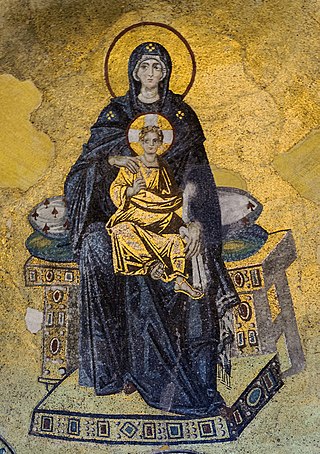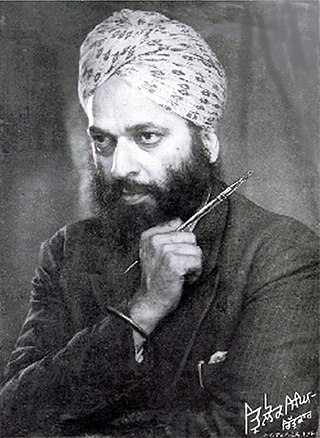Related Research Articles

Marc Quinn is a British contemporary visual artist whose work includes sculpture, installation, and painting. Quinn explores "what it is to be human in the world today" through subjects including the body, genetics, identity, environment, and the media. His work has used materials that vary widely, from blood, bread and flowers, to marble and stainless steel. Quinn has been the subject of solo exhibitions at Sir John Soane's Museum, the Tate Gallery, National Portrait Gallery, Fondation Beyeler, Fondazione Prada, and South London Gallery. The artist was a notable member of the Young British Artists movement.

Religious art is a visual representation of religious ideologies and their relationship with humans. Sacred art directly relates to religious art in the sense that its purpose is for worship and religious practices. According to one set of definitions, artworks that are inspired by religion but are not considered traditionally sacred remain under the umbrella term of religious art, but not sacred art.

Sir Grayson Perry is an English artist. He is known for his ceramic vases, tapestries, and cross-dressing, as well as his observations of the contemporary arts scene, and for dissecting British "prejudices, fashions and foibles".
Dame Sonia Dawn Boyce is a British Afro-Caribbean artist and educator who lives and works in London. She is a Professor of Black Art and Design at University of the Arts London. Boyce's research interests explore art as a social practice and the critical and contextual debates that arise from this area of study. Boyce has been closely collaborating with other artists since 1990 with a focus on collaborative work, frequently involving improvisation and unplanned performative actions on the part of her collaborators. Boyce's work involves a variety of media, such as drawing, print, photography, video, and sound. Her art explores "the relationship between sound and memory, the dynamics of space, and incorporating the spectator". To date, Boyce has taught Fine Art studio practice for more than 30 years in several art colleges across the UK.

Amrita Sher-Gil was a Hungarian–Indian painter. She has been called "one of the greatest avant-garde women artists of the early 20th century" and a pioneer in modern Indian art. Drawn to painting from an early age, Sher-Gil started formal lessons at the age of eight. She first gained recognition at the age of 19, for her 1932 oil painting Young Girls. Sher-Gil depicted everyday life of the people in her paintings.

Sobha Singh was an artist from Punjab, India.
Rita A Donagh is a British artist, known for her realistic paintings and painstaking draughtsmanship.
The Sikhs are adherents to Sikhism, the fifth largest organized religion in the world, with around 25 million adherents. Sikh History is around 500 years and in that time the Sikhs have developed unique expressions of art and culture which are influenced by their faith and synthesize traditions from many other cultures depending on the locality of the adherents of the religion. Sikhism is the only religion that originated in the Punjab region with all other religions coming from outside Punjab. All the Sikh gurus, many saints, and many of the martyrs in Sikh history were from Punjab and from the Punjabi people. Punjabi culture and Sikhism are mistakenly considered inseparably intertwined. "Sikh" properly refers to adherents of Sikhism as a religion, strictly not an ethnic group. However, because Sikhism has seldom sought converts, most Sikhs share strong ethno-religious ties, therefore it is a common stereotype that all Sikhs share the same ethnicity. Many countries, such as the U.K., therefore misconcievingly recognize Sikh as a designated ethnicity on their censuses. The American non-profit organization United Sikhs has fought to have Sikhs included on the U.S. census as well, arguing that Sikhs "self-identify as an 'ethnic minority'" and believe "that they are more than just a religion".

Arpita Singh is an Indian artist. Known to be a figurative artist and a modernist, her canvases have both a story line and a carnival of images arranged in a curiously subversive manner. Her artistic approach can be described as an expedition without destination. Her work reflects her background. She brings her inner vision of emotions to the art inspired by her own background and what she sees around the society that mainly affects women. Her works also include traditional Indian art forms and aesthetics, like miniaturist painting and different forms of folk art, employing them in her work regularly.

Lubaina Himid is a British artist and curator. She is a professor of contemporary art at the University of Central Lancashire. Her art focuses on themes of cultural history and reclaiming identities.

Chila Kumari Singh Burman is a British artist, celebrated for her radical feminist practice, which examines representation, gender and cultural identity. She works across a wide range of mediums including printmaking, drawing, painting, installation and film.
Paula MacArthur is an English artist. MacArthur was joint first prize winner in 1989 of the ‘John Player Portrait Award’ at the National Portrait Gallery, London with Tai-Shan Schierenberg. In 1993 she graduated from the Royal Academy of Arts where she was awarded the ‘Royal Academy Schools Prize for Painting’, that same year she was a prize winner of ‘Liverpool John Moores 18’. Her work is held in numerous collections including The National Portrait Gallery, London the collection of Baron and Baroness von Oppenheim and The Priseman Seabrook Collection.

Joseph Parry (1756–1826) was a British painter and engraver. He was popularly known by his contemporaries as Old Parry to distinguish him from his sons James Parry and David Henry Parry, also artists.
Phulan Rani is an Indian painter.

Trilok Singh Chitarkar (1914-1990) was a versatile Indian painter. He has unique style of presenting himself through variety of themes - Sikh religion, history, culture, folk lore, love legends, portraits, social evils, nature, illustration of Gurbani, Shabads, visuals in Punjabi Encyclopedia and books. He was well versed with deep knowledge of Gurbani, history and religion. He knew many languages i.e. Gurmukhi, Punjabi, Hindi, English, Urdu, Persian, Assamese and Bengali. He translated articles from Bengali to Punjabi and published these in the book titled Bangla De Daab in 1974. The Artist was honoured in 1973 by the Chief Minister, Punjab, India Giani Zail Singh at a state level function organised at his residence, Chitralok, Patiala. Language department, Punjab published a book in Punjabi-Chitralok's Contribution to Art and released on the 70th birthday of the artist, 10 December 1984 at a special function organised in Central Library at Patiala for his contribution to Art.
Grayson's Art Club is a Channel 4 television documentary series focused on the COVID-19 pandemic and the lockdown. It was hosted by artist Grayson Perry and his wife Philippa Perry. Its first broadcast was during the early months of the COVID-19 pandemic, between 27 April and 1 June 2020.
Jagjit Chuhan is an Indian-British artist, art curator and art lecturer. She is Professor of International Art at Liverpool John Moores University.
sikhchic.com is a Sikh online magazine covering Sikh culture, art, and humour. It is one of the leading online magazines for Sikhs.

Kehar Singh (1820–1882) was a Sikh artist who was employed as a court painter by the Sikh states of Lahore and Kapurthala. Baba Kehar Singh Musawar was a prominent artist of the Sikh Naqqashi school of art and helped innovate it. The art of frescoes was introduced by the artist Bhai Kehar Singh Musawar under the patronage of Maharaja Ranjit Singh during the era of the Sikh Empire. He was one of the most important of the court painters of Ranjit Singh. Kehar Singh and his family were honoured as Fakhr-e-Qoum.
References
- ↑ "Contemporary Connections: The Singh Twins". www.npg.org.uk. National Portrait Gallery. 2010. Retrieved 5 December 2020.
- 1 2 3 Vaswani, Anjana (12 November 2022). "Singh twins exhibition | Horrifyingly beautiful". India Today. Archived from the original on 7 October 2024. Retrieved 7 October 2024.
- 1 2 3 4 5 6 Peter Stanford (29 March 2009). "Seeing as one: Why has the British establishment never quite accepted the Singh Twins?" . The Independent. Archived from the original on 18 June 2022. Retrieved 5 December 2020.
- 1 2 3 4 5 Leo Mirani (18 November 2010). "Sister act: the Singh Twins". The Guardian. Retrieved 5 December 2020.
- 1 2 Laurence Saunders (23 February 2018). "Interview: Renowned Wirral-raised artists The Singh Twins". Your Magazine Liverpool. Archived from the original on 4 September 2019. Retrieved 5 December 2020.
- ↑ "Studio visit: The Singh Twins". www.christies.com. Christies. 10 May 2016. Archived from the original on 3 July 2022. Retrieved 5 December 2020.
- ↑ "Meet The Artists - The Singh Twins". Manchester Museum. Retrieved 9 October 2024.
- ↑ "Grayson's Art Club". manchesterartgallery.org. Manchester Art Gallery. 25 November 2020. Retrieved 5 December 2020.
- ↑ "Grayson's Art Club: Series 1 Episode 6 - All 4".